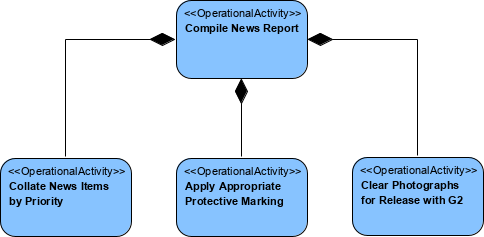The OV-5a and the OV-5b describe the operations that are normally conducted in the course of achieving a mission or a business goal. It describes operational activities (or tasks); Input/Output flows between activities, and to/from activities that are outside the scope of the Architectural Description.
The activities described in an OV-5a or OV-5b are standard Operational Activities that are mapped to corresponding capabilities in the CV-6 Capability to Operational Activities Mapping. Standard Operational Activities are those defined in doctrine, but which are not tailored to a specific system, i.e., they are generic enough to be used without closing off a range of possible solutions.
There are two ways to depict activity models:
- OV-5a: The Activity Decomposition Tree shows activities depicted in a tree structure and is typically used to provide a navigation aid.
- OV-5b: The Activity Model shows activities connected by Resource Flows; it supports the development of an OV-3 Operational Resource Flow Matrix.
Usage
The intended usage of the OV-5a includes:
- Description of activities and workflows.
- Requirements capture.
- Definition of roles and responsibilities.
- Support task analysis to determine training needs.
- Problem space definition.
- Operational planning.
- Logistic support analysis.
- Information flow analysis.
Product Description
The OV-5 Operational Activity Decomposition Tree helps provide an overall picture of the activities involved and a quick reference for navigating the OV-5b, Operational Activity Model.
Creating an Operational Activity Decomposition Tree
To create an Operational Activity Decomposition Tree:
- Click on Operational Activity Decomposition Tree in the Action Artifact area, and then select Create New Diagram.
- Type the diagram name and press Enter.
- A blank diagram is created and you can start constructing the view. Create OperationalActivities and/or StandardOperationalActivities through the tools under the diagram toolbar.
Optional actions:
Reuse OperationalPerformers (recommended) through dragging and dropping them from the Model Explorer, and traces the OperationalPerformers to the OperationalActivities using the IsCapableToPerform connector.

DoDAF in Visual Paradigm
The DoDAF is brought to you by Visual Paradigm, a full-featured development platform. Visual Paradigm provides an easy-to-use, model-driven DoDAF tool that supports the development of DoDAF 2.02 views and models. You can create integrated DoDAF products and generate architectural documents that facilitate organizations to efficiently coordinate enterprise architecture initiatives.